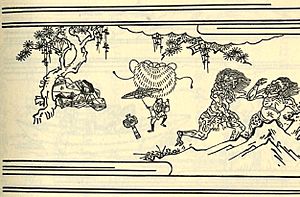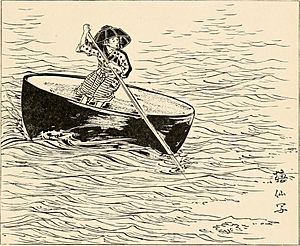Issun-bōshi facts for kids

Issun-bōshi (一寸法師) is a famous fairy tale from Japan. His name means "One-Sun Boy." A "sun" is an old Japanese measurement, about 3 centimeters (1.2 inches). So, he is a tiny boy! You might also hear him called "Little One-Inch" or "The Inch-High Samurai." This story is found in an old Japanese book called Otogizōshi. It's a bit like the English story of Tom Thumb, another tiny hero.
Contents
The Story of Issun-bōshi
Here is the most common version of the Issun-bōshi story:
- An old couple really wanted a child. They prayed to the gods, and soon they had a baby boy.
- But this child was only one sun tall. He never grew any bigger! So, they named him Issun-bōshi, the "one-sun boy."
- One day, Issun-bōshi decided to go to the capital city. He wanted to become a brave warrior.
- He set off on his journey. His boat was a bowl, his paddle was a chopstick. He used a needle as a sword and a piece of straw as its cover.
- In the capital, he found a grand house. He got a job there.
- One day, a girl from the family went to visit a palace. An oni (a Japanese ogre or demon) suddenly grabbed her!
- Issun-bōshi bravely tried to save the girl. The oni was huge and swallowed him whole!
- But Issun-bōshi was clever. He used his needle-sword to poke the oni's stomach.
- The oni cried out, "It hurts! Stop!" It then spat Issun-bōshi out and ran away into the mountains.
- The oni dropped a special magic hammer called an Uchide no kozuchi. Issun-bōshi picked it up.
- He swung the magic hammer, and it made him grow! He became a tall man, about 182 centimeters (6 feet) tall.
- Issun-bōshi then married the girl he saved. People say he used the magic hammer to create food and treasures. His family became very successful for many years.
Other Versions of the Story
The story in the old book Otogi-zōshi has some small differences:
- The old couple worried about Issun-bōshi's tiny size. They thought he might be a monster. So, Issun-bōshi left their home.
- In the capital, Issun-bōshi lived in a high-ranking official's house.
- He fell in love with the official's daughter. But he knew she wouldn't marry someone so small.
- So, he came up with a plan. He put some rice grains from the family altar into the girl's mouth. Then he pretended to cry, saying she stole his rice.
- The official believed Issun-bōshi and wanted to punish his daughter. Issun-bōshi stepped in and left the house with the daughter.
- They sailed away on a boat. It landed on a spooky island. There, they met an oni.
- The oni swallowed Issun-bōshi. But Issun-bōshi was so small he could go in and out of the oni's eye!
- This happened many times until the oni got angry and left, dropping the magic hammer.
- News of Issun-bōshi spread. The emperor heard about him and liked him. He gave Issun-bōshi a high position in the palace.
Other old stories also have different parts:
- Some tales say Issun-bōshi tricked the daughter so he could be in charge of her.
- In some versions, the boy uses the magic hammer to grow tall and then marries the girl.
- A few stories only talk about him beating the oni. They don't mention him growing bigger or his clever plans.
The story also changes a bit depending on where in Japan it is told.
Issun-bōshi in Children's Books and Songs
- A famous children's book called Nihon Mukashibanashi (meaning "Old Tales of Japan") helped make the Issun-bōshi story popular. It was first published in 1896 by Iwaya Sazanami.
- This version made Issun-bōshi a more lovable character. It removed any parts that seemed mean from the older stories. Most children's books today follow this popular version.
- A well-known picture book about Issun-bōshi was written by Ishii Momoko. It was illustrated by Akino Fuku and came out in 1965.
- The French fairy tale Hop-o'-My-Thumb by Charles Perrault also came to Japan. It was called Shōsetsu Issun Bōshi (Novelized Issun Bōshi) and was published in a magazine in 1896.
Songs About Issun-bōshi
- In 1905, a song called "Issun Bōshi" was included in a school songbook. It was written by Iwaya Sazanami. Children in Japan still sing this song today!
Other Story Versions
There are many ways the Issun-bōshi story has been told. Some versions are quite different from the original.
The Mamesuke Version
The Mamesuke version of Issun-bōshi is similar but has some key differences:
- Instead of being born normally, Issun-bōshi was born from a swelling on his mother's thumb.
- He was called Mamesuke, which means "bean boy."
- He still leaves home but only has a bag of flour with him.
- He finds a rich wine merchant with three daughters. Mamesuke wants to marry the middle daughter.
- He works for the merchant. One night, he puts flour on the daughter's mouth. He throws the rest of the flour into the river.
- In the morning, he pretends his flour is gone. The family finds flour on the middle daughter.
- Even though she says she didn't do it, her family gives her to Mamesuke as payment.
- As they travel home, the girl is very angry. She tries to find ways to harm him, but she can't.
- When Mamesuke gets home, his parents are happy to see the girl. They prepare a hot bath for him.
- Mamesuke asks his new bride to help him wash. But she comes in with a broom and stirs the water to try and drown him.
- Suddenly, Mamesuke's body bursts open! A full-sized man steps out.
- Everyone is surprised and very happy. Mamesuke and his bride live happily with his parents.
Modernized Issun-bōshi
Modern versions of Issun-bōshi are often changed to fit today's world:
- Instead of leaving on his own, Issun-bōshi's parents send him to learn about the world.
- He still goes to the capital and lives with a wealthy lord.
- In these stories, the lord's daughter and others in the house like him right away.
- Issun-bōshi and the girl still face ogres and get the lucky mallet.
- He uses the mallet to become normal-sized and grows into a fine young samurai.
- Sometimes, these stories have an open ending. It's not always clear what happens to Issun-bōshi next. This lets the audience imagine their own ending.
Images for kids
-
"Issun-bōshi" from Otogizōshi


